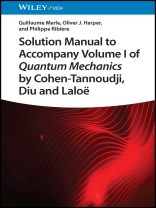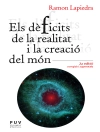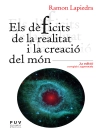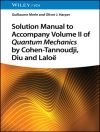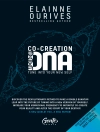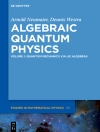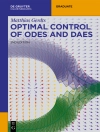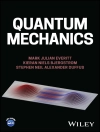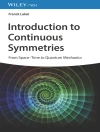Solution Manual to Accompany Volume I of Quantum Mechanics by Cohen-Tannoudji, Diu and Laloë
Grasp the fundamentals of quantum mechanics with this essential set of solutions
Quantum mechanics, with its counter-intuitive premises and its radical variations from classical mechanics or electrodynamics, is both among the most important components of a modern physics education and one of the most challenging. It demands both a theoretical grounding and a grasp of mathematical technique that take time and effort to master. Students working through quantum mechanics curricula generally practice by working through increasingly difficult problem sets, such as those found in the seminal Quantum Mechanics volumes by Cohen-Tannoudji, Diu and Laloë.
This solution manual accompanies Volume I and offers the long-awaited detailed solutions to all 69 problems in this text. Its accessible format provides explicit explanations of every step, focusing on both the physical theory and the formal mathematics, to ensure students grasp all pertinent concepts. It also includes guidance for transferring the solution approaches to comparable problems in quantum mechanics.
Readers also benefit from:
- Approximately 70 figures to clarify key steps and concepts
- Detailed explanations of problems concerning quantum mechanics postulates, mathematical tools, properties of angular momentum, and more
This solution manual is a must-have for students in physics, chemistry, or the materials sciences looking to master these challenging problems, as well as for instructors looking for pedagogical approaches to the subject.
Inhaltsverzeichnis
1 Solutions to the Exercises of Chapter I (Complement KI). Waves and Particles. Introduction to the Fundamental Ideas of Quantum Mechanics 1
1.1 Interference and Diffraction with a Beam of Neutrons 1
1.2 Bound State of a Particle in a “Delta Function Potential” 3
1.3 Transmission of a “Delta Function” Potential Barrier 9
1.4 Bound State of a Particle in a “Delta Function Potential”, Fourier Analysis 13
1.5 Well Consisting of Two Delta Functions 24
1.6 Bound State in a Square Potential 38
1.7 The Piecewise Constant Lennard–Jones Potential 43
1.8 Two-Dimensional Potential 47
2 Solutions to the Exercises of Chapter II (Complement HII). The Mathematical Tools of Quantum Mechanics 55
Dirac Notation. Commutators. Eigenvectors and Eigenvalues 55
2.1 A First Approach 55
2.2 Diagonalization, Orthonormal Basis, Closure Relation 58
2.3 Superposition of States 64
2.4 A Ket-Bra Operator 66
2.5 Orthogonal Projector 67
2.6 Σ X Matrix 68
2.7 σ y Matrix 70
2.8 Hamiltonian H of a Particle in a One-Dimensional Problem 72
2.9 Toward the Virial Theorem in Quantum Mechanics 74
2.10 Operators X and P 77
Complete Sets of Commuting Observables, C.S.C.O. 78
2.11 A C.S.C.O. of a Three-State System 78
2.12 A C.S.C.O. of Two Operators 81
3 Solutions to the Exercises of Chapter III (Complement LIII). The Postulates of Quantum Mechanics 85
3.1 Analysis of a One-Dimensional Wave Function 85
3.2 Probability and One-Dimensional Wave Function 88
3.3 Wave Function Defined Using Momenta 90
3.4 Spreading of a Free Wave Packet 96
3.5 Particle Subjected to a Constant Force 100
3.6 Three-Dimensional Wave Function 103
3.7 Generic Three-Dimensional Wave Function 106
3.8 Probability Current 108
3.9 Complete Description of a Quantum State Using the Probability Density and Probability Current 112
3.10 Virial Theorem 115
3.11 Two-Particle Wave Function 119
3.12 Infinite One-Dimensional Well 123
3.13 Infinite Two-Dimensional Well (cf Complement GII) 126
3.14 Temporal Evolution Within a Coupled Three-Level System 133
3.15 Interaction Picture 138
3.16 Correlations Between Two Particles 143
3.17 Introduction to the Density Matrix (or Density Operator) 157
3.18 Temporal Evolution of the Density Matrix 160
3.19 Two-Particle Density Matrix 161
References 164
4 Solutions to the Exercises of Chapter IV (Complement JIV). Application of the Postulates to Simple Cases: Spin 1/2 and Two-Level Systems 165
4.1 First Approach to Spin States and Quantum Precession 165
4.2 Continuation of the First Approach with a Nonstationary Magnetic Field 170
4.3 Continuation of the First Approach with a Magnetic Field with Two Components 174
4.4 Density Matrix and Spin Measurements 178
4.5 Evolution Operator of a Spin 1/2 (cf Complement F III) 186
4.6 Study of the Spin State of Two Particles Described by a Single Wave Function 190
4.7 Continuation of the Study of the Two-Particle Spin State Described by a Single Wave Function 196
4.8 Linear Triatomic Molecule 202
4.9 Hexagonal Molecule 209
Reference 217
5 Solutions to the Exercises of Chapter V (Complement MV). The One-Dimensional Harmonic Oscillator 219
5.1 One-Dimensional Harmonic Oscillator 220
5.2 Anisotropic Three-Dimensional Harmonic Oscillator 225
5.3 Harmonic Oscillator: Two Particles, Part I 232
5.4 Harmonic Oscillator: Two Particles, Part II 240
5.5 Harmonic Oscillator: Two Particles, Part III 249
5.6 Charged Harmonic Oscillator in a Variable Electric Field 255
5.7 A Fourier-Like Operator Applied to a One-Dimensional Harmonic Oscillator 266
5.8 The Time Evolution Operator Applied to a One-Dimensional Harmonic Oscillator 269
6 Solutions to the Exercises of Chapter VI (Complement FVI). General Properties of Angular Momentum in Quantum Mechanics 283
6.1 Mean Value of a Magnetic Moment for a Given State 283
6.2 Magnetic Moment Measurement in a Four-Dimensional Space 286
6.3 Link Between the Classical Angular Momentum and the Corresponding Quantum Operator 293
6.4 Rotation of a Polyatomic Molecule 295
6.5 Study of the Angular Part of a Wave Function 310
6.6 An Electric Quadrupole in an Electric Field Gradient 314
6.7 On Rotational Matrices 322
6.8 Rotation and Angular Momentum 326
6.9 Fluctuations and Angular Momentum Measurements 330
6.10 Heisenberg-Type Relations for Angular Momenta 340
6.11 State Minimizing Angular Momentum Fluctuations 344
Reference 353
7 Solutions to the Exercises of Chapter VII (Complement GVII). Particle in a Central Potential. The Hydrogen Atom 355
7.1 Particle in a Cylindrically Symmetric Potential 355
7.2 Three-Dimensional Harmonic Oscillator in a Uniform Magnetic Field 361
Bibliography 377
Über den Autor
Guillaume Merle, Ph D, is Professeur agrégé of Mechanics at Beihang Sino-French Engineer School, Beihang University, Beijing, China, where he supervises the Engineering Science Department and is in charge of the Engineering Science, Engineering Thermodynamics, and Quantum Physics courses.
Oliver J. Harper, Ph D, is Professeur agrégé of Physics at Lycée Saint Lambert, Paris, France, where he teaches physics and chemistry in the Preparatory Classes for the French ‚Grandes Écoles‘.
Philippe Ribière, Ph D, is Professeur agrégé of Physics at Beihang Sino-French Engineer School, Beihang University, Beijing, China, where he supervises the Physics Department and is in charge of the Statistical Physics course.
